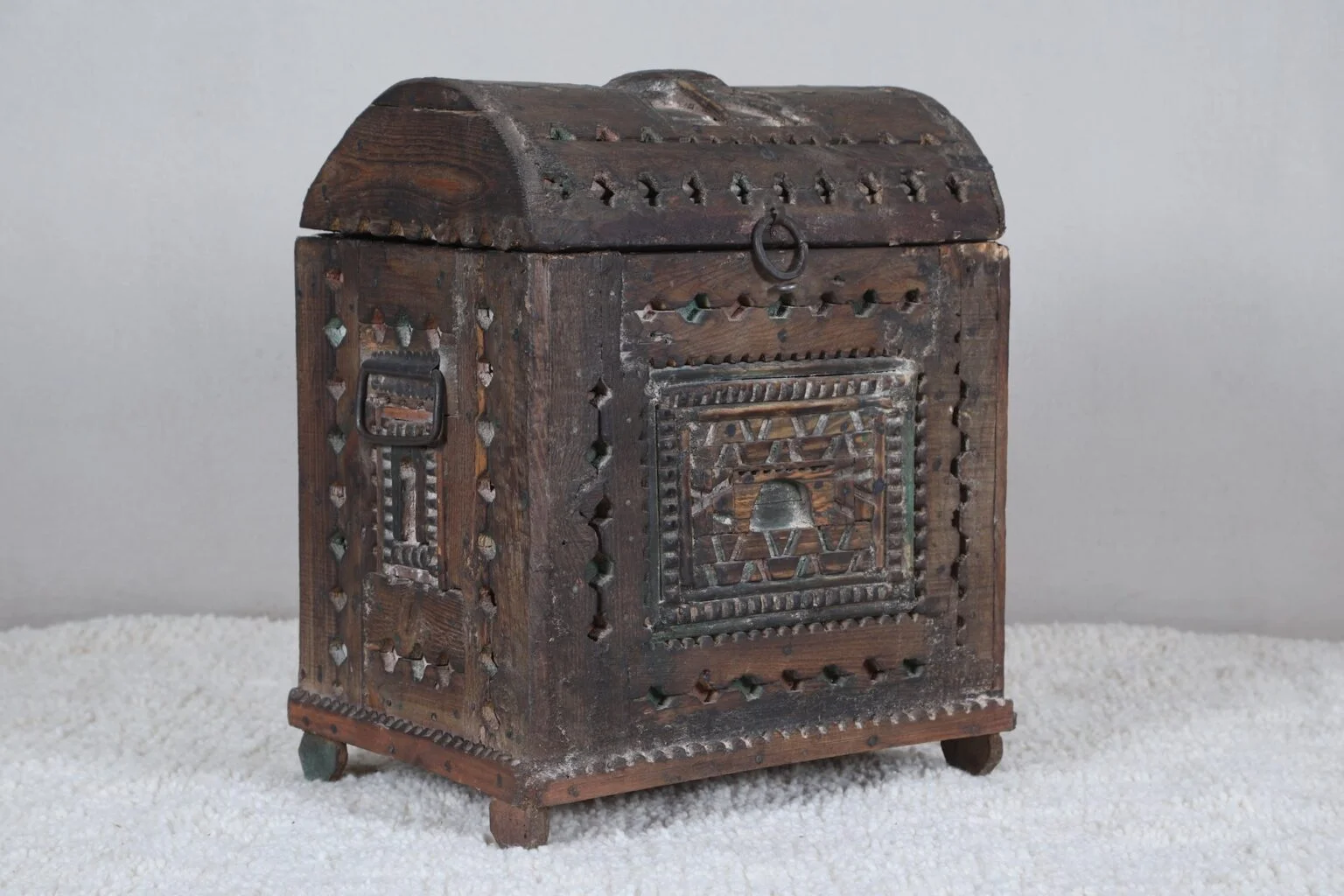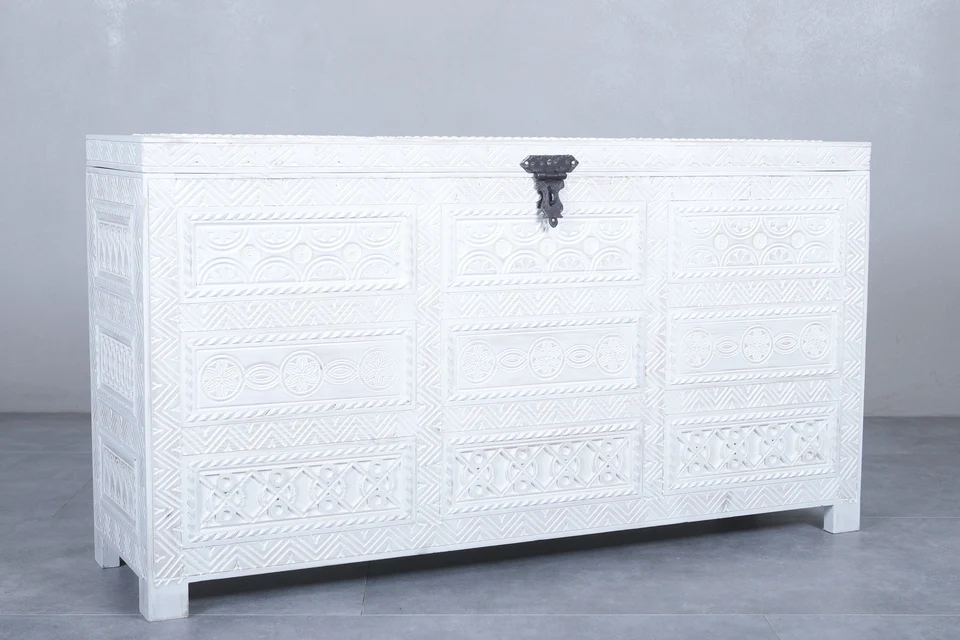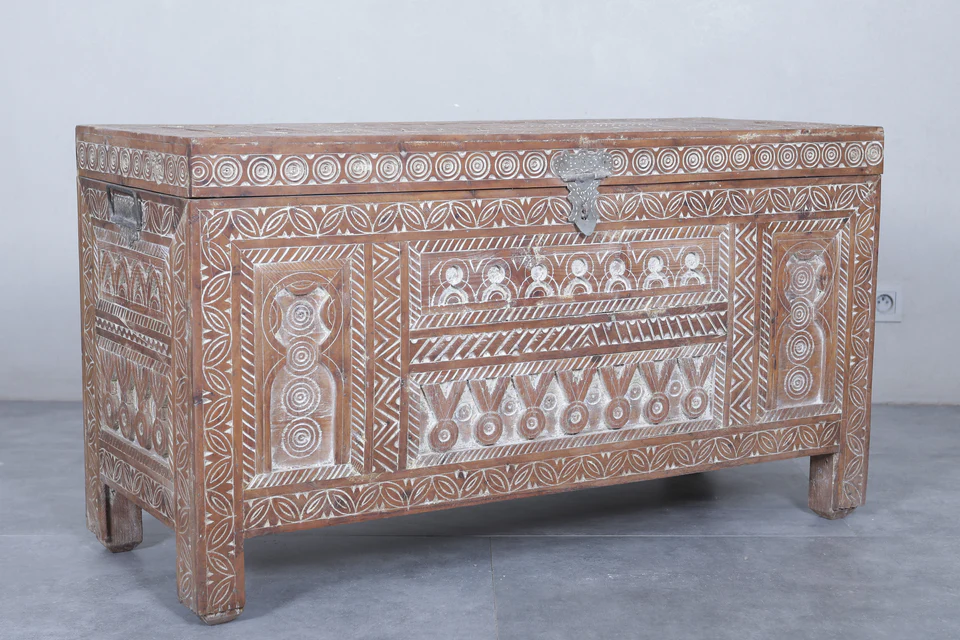Introduction to Moroccan Chests
Moroccan chests represent a unique confluence of artistry and utility, deeply rooted in the rich cultural and historical tapestry of Morocco. Originating from a tradition of meticulous craftsmanship, these chests have long been integral to Moroccan households. They were traditionally used for storing valuables, clothing, and important documents, reflecting their practical utility. Over centuries, however, they have also come to signify a display of intricate craftsmanship and cultural heritage.
The construction of Moroccan chests typically involves the use of high-quality wood, often embellished with detailed carvings, metal inlays, and vibrant hand-painted designs. This intricate work is a testament to the skills passed down through generations of Moroccan artisans. Each chest tells a story, not only of the artisan who created it but also of the cultural motifs and historical influences that shape Moroccan art. The blend of Islamic, Berber, Spanish, and French artistic influences can often be observed in the elaborate patterns and designs adorning these pieces.
In the modern era, Moroccan chests have transcended their traditional roles. They are now cherished as versatile furniture pieces that effortlessly blend into various interior design styles, from rustic and traditional to modern and eclectic. Their functionality extends beyond mere storage, serving as statement pieces that can enhance the aesthetic appeal of any living space. A wood chest can serve as a coffee table, a chic console, or even as a focal point in a bedroom, combining utility with artistic expression.
Overall, the allure of Moroccan chests lies in their ability to harmonize craftsmanship with functionality. These creations continue to captivate with their timeless elegance and rich historical significance, making them highly sought-after pieces in both traditional and contemporary settings. The enduring appeal of Moroccan chests is a testament to the enduring legacy of Moroccan artisanship and the cultural heritage it preserves.
The History and Cultural Significance
Moroccan chests, encapsulating centuries of craftsmanship, present a rich tapestry of cultural heritage and tradition. The origins of these ornate storage pieces can be traced back to ancient times, where their practical utility was intertwined with intricate artistry. Historical records highlight the presence of Moroccan chests in Berber and Arab households, serving both as functional storage solutions and as symbols of wealth and status.
The design and craftsmanship of Moroccan chests have evolved substantially over the centuries. Initially, these chests were crafted using local materials such as cedar wood, known for its durability and pleasant aroma. Carvings and inlays, often inspired by Islamic art and Berber motifs, adorned these chests, reflecting the intricate patterns that are a hallmark of Moroccan design. Gold and silver leaf were sometimes used to embellish the chests, further elevating their aesthetic and cultural value.
During the medieval period, the influence of Andalusian craftsmanship introduced new elements to Moroccan chests, such as the use of marquetry and geometric patterns. This cross-cultural exchange enriched the design lexicon, making Moroccan chests not just utilitarian objects but also magnificent works of art. The Ottoman era brought another wave of stylistic influences, incorporating more floral and arabesque designs, which continued to be popular in subsequent periods.
In contemporary times, Moroccan chests continue to hold significant cultural value. Within Moroccan homes, these chests often occupy a central place in living spaces, used to store valuables such as textiles, jewelry, and family heirlooms. They are viewed as custodians of tradition, preserving familial and cultural heritage through generations. The chests also play an important role in Moroccan weddings, where they are used in ceremonial gift exchanges and dowries, symbolizing prosperity and continuity.
The ongoing relevance of Moroccan chests in modern households is a testament to their enduring appeal and versatility. They serve not only as functional storage units but also as cherished pieces of cultural heritage, encapsulating the rich history and intricate craftsmanship that define Moroccan art and tradition.
Materials and Techniques Used in Moroccan Chests
Moroccan chests are renowned for their intricate craftsmanship and utilization of high-quality materials that stand the test of time. One of the primary materials used in creating these exquisite pieces is cedar wood. Celebrated for its durability and aromatic qualities, cedar wood not only offers longevity but also brings a distinct natural fragrance that has been cherished for centuries. Artisans often select premium cedar wood for its fine grain and workability, ensuring each chest exudes luxury and artistry.
In addition to cedar wood, metal inlays are a hallmark of Moroccan chests. Brass, bronze, and occasionally silver, are meticulously inlaid into the wood, adding a layer of elegance and complexity to the designs. These metal accents often form intricate geometric patterns or traditional Moroccan motifs, each requiring hours of meticulous work. The process involves precision and a steady hand, highlighting the artisan’s dedication to their craft.
Leather is another material commonly found in the construction of Moroccan chests. It’s frequently used for decorative touches, bindings, and even protective coverings. High-quality leather, often sourced locally, is dyed using natural pigments, and embossed or tooled with detailed designs. This incorporation of leather not only enhances the aesthetic appeal but also contributes to the overall durability and tactile experience of the piece.
The techniques employed by Moroccan artisans blend traditional methods with contemporary innovations. Traditional woodworking techniques include carving intricate designs directly into the wood using hand tools. This process is deeply rooted in Morocco’s cultural heritage and takes years of practice to perfect. Artisans also utilize modern tools for precision cuts and assembly, ensuring each chest is built to exacting standards.
Metal inlay work involves heating and bending the metal before it is carefully hammered into grooves carved into the wood. This technique requires both skill and patience, as errors can be difficult to rectify. The incorporation of modern technology, such as laser cutting for intricate patterns, has made it possible to produce even more complex designs without compromising the artisanal quality.
Leatherworking, too, benefits from advancements in both material treatments and tooling. Modern dyes and finishes extend the leather’s life and maintain its vibrant colors, while traditional methods of embossing and tooling continue to be favored for their hands-on authenticity. The resulting chests represent a fusion of time-honored craftsmanship and contemporary precision.
Design Characteristics and Aesthetic Appeal
Moroccan chests are renowned for their intricate design characteristics and aesthetic appeal, which make them exceptional pieces of furniture. A prominent feature of these chests is their geometric patterns, often embodying elements of Islamic art. These intricate designs, meticulously carved or inlaid, exemplify the artisans’ attention to detail and their deep understanding of symmetry and proportion. The geometric patterns are not merely decorative; they also convey a sense of infinity and timelessness, reflecting the spiritual and cultural values of Moroccan craftsmanship.
Another defining characteristic of Moroccan chests is the elaborate carvings that adorn their surfaces. These carvings often include arabesque motifs, floral patterns, and calligraphic designs, each telling a story or representing a significant cultural symbol. The skilled artisans who create these ornate designs employ traditional techniques passed down through generations. This dedication to craft ensures that each chest is a unique masterpiece, imbued with cultural heritage and artistic excellence.
Vibrant colors also play a crucial role in the appeal of Moroccan chests. Typically, these chests feature a rich palette, including deep reds, blues, greens, and golds. The application of these colors is done using natural dyes, which not only enhance the visual allure but also contribute to the longevity of the piece. The combination of vivid hues alongside the detailed carvings and patterns creates a visually striking effect, making each chest a focal point in any setting.
The aesthetic principles that underpin Moroccan chests are deeply rooted in the region’s history and traditions. The balance of elaborate detail and harmonious color schemes exemplifies the Moroccan approach to design—one that celebrates beauty, functionality, and cultural significance. These chests are more than just storage solutions; they are works of art that capture the essence of Moroccan craftsmanship and its enduring appeal.
Moroccan chests epitomize the seamless blend of craftsmanship and functionality, making them treasured possessions across various settings. Traditionally, these intricately designed chests served dual purposes of storage and security. Crafted from robust woods and adorned with elaborate metalwork, they were ideal for safeguarding valuables such as jewelry, important documents, and even clothes. The built-in locking mechanisms and sturdy builds ensured these contents remained secure, thereby earning their place as household essentials.
Beyond their traditional roles, Moroccan chests have evolved to find contemporary applications that add to their allure in modern homes. One of the most popular modern uses is incorporation into living spaces as coffee tables. The intricate detailing and rich history encapsulated within each chest make them extraordinary focal points, effortlessly elevating the aesthetic of a living room. Furthermore, their ample interior space serves as a clever storage solution, perfect for stashing away throw blankets, books, or other living room essentials.
Another notable modern application of Moroccan chests is their role as statement pieces in home decor. Whether placed at the foot of a bed, in a hallway, or in an office setting, these chests enhance the ambiance with their unique blend of artistry and practicality. Their versatile design means they can be effortlessly integrated into diverse decor styles, from eclectic and bohemian to minimalist and industrial. Thus, Moroccan chests are not just storage units but also form pieces of art that narrate tales of rich cultural heritage.
Additionally, Moroccan chests have found their place in dining areas as buffet tables or sideboards. They provide an elegant solution for storing dining essentials like utensils, tableware, and linen while simultaneously offering a decorative touch. Their multifunctionality makes them practical investments for those seeking both utility and aesthetics in their home furniture. Indeed, whether serving as a functional storage unit or an ornamental masterpiece, Moroccan chests continue to be cherished for their exceptional blend of craftsmanship and functionality.
Incorporating Moroccan Chests into Modern Decor
Moroccan chests, renowned for their intricate craftsmanship, provide a unique opportunity to blend traditional artistry with modern interior design. The adaptability of these elegant pieces allows them to be seamlessly integrated into various contemporary settings, offering both aesthetic appeal and functional benefits. Here are some tips and ideas on how to effectively incorporate Moroccan chests into your modern decor.
When introducing Moroccan chests into a living room, consider using them as coffee tables or accent pieces. Their ornate detailing can serve as a focal point in a minimalist space, providing a rich contrast to clean lines and neutral tones. Additionally, their storage capability makes them practical for stowing away blankets, magazines, or other living room essentials.
In a bedroom, a Moroccan chest can replace conventional bedside tables or be placed at the foot of the bed. This positioning not only enhances the room’s aesthetic with a touch of exotic allure but also offers a convenient storage solution for linens, books, or personal belongings. The versatility of Moroccan chests is especially valuable in rooms that blend Bohemian, Scandinavian, or eclectic styles, where the fusion of textures and cultural elements is celebrated.
For dining areas, Moroccan chests can be repurposed as buffet tables or sideboards. Their unique craftsmanship can complement rustic, industrial, or even contemporary table settings, adding depth and character to the space. The storage compartments are ideal for keeping dinnerware, table linens, and other dining accessories organized and within easy reach.
Integrating Moroccan chests into modern homes emphasizes their functional elegance. Whether placed in a hallway, serving as a media console, or acting as a decorative piece in an entryway, these chests are more than just storage units. They are a testament to timeless craftsmanship that harmoniously blends with various decor styles.
Preserving and Maintaining Your Moroccan Chest
Ensuring the longevity of your Moroccan chest requires a thoughtful approach to its preservation and maintenance. These beautifully crafted pieces are renowned for their intricate designs and robust functionality. However, their unique materials and construction necessitate specific care routines to keep them in pristine condition over the years.
Firstly, regular cleaning is essential. Dust and debris can easily accumulate in the detailed carvings and metal inlays. Use a soft, dry cloth to gently wipe down the surface of the chest. For intricate areas that are harder to clean, a soft-bristled brush can be useful to dislodge dirt without damaging the finish. While it may be tempting to use commercial cleaning products, it is advisable to avoid harsh chemicals as they can tarnish the wood, metalwork, and any surface coatings.
Polishing is another key aspect of preserving the beauty of your Moroccan chest. Depending on the materials used, natural beeswax or a specially formulated wood polish should be applied sparingly. This helps maintain the wood’s natural luster and protects it from drying out. For chests with metal inlays or fittings, consider using a gentle metal polish to prevent tarnishing while restoring shine. Always test any product on a small, inconspicuous area first to ensure it doesn’t cause discoloration.
Protection from environmental factors is also crucial. Moroccan chests should preferably be kept in environments where temperature and humidity levels are consistent. Excessive moisture can lead to swelling or warping of the wood, while too much dryness can cause cracking. It’s best to place these chests away from direct sunlight to prevent fading of colors and avoid positioning them near heat sources to protect the materials from heat damage.
Lastly, addressing wear and tear promptly can significantly extend the life of your chest. If you notice any loose fittings or minor cracks, consult a professional restorer with experience in Moroccan craftsmanship for appropriate repairs. Regular checks and timely interventions will ensure that these valuable pieces of furniture remain both functional and aesthetically pleasing for generations.
Where to Find Authentic Moroccan Chests
Finding authentic Moroccan chests requires discerning buyers to know where to look, both online and offline. Ensuring the purchase of a genuine piece involves researching reputable sources known for their dedication to authentic craftsmanship.
One prime option for online shopping is Moroccan House Bazaar, an e-commerce platform celebrated for its extensive collection of Moroccan furniture. They work directly with Moroccan artisans, ensuring that each chest is hand-crafted and reflects traditional Moroccan artistry. Similarly, Souq Artisan is another trusted online store that provides detailed descriptions and authenticity certificates for each item, helping buyers avoid counterfeit products.
For those who prefer physical shopping, visiting specialty stores in artisan districts offers the advantage of examining the chests up close. In cities like Marrakech and Fez, boutique shops and markets such as Souk Semmarine and Rue des Consuls are renowned for their authentic Moroccan crafts. These venues often allow direct interaction with artisans, providing insight into the meticulous craftsmanship involved in each piece.
To identify authentic Moroccan chests and avoid counterfeit products, pay close attention to the craftsmanship details. Authentic chests will often feature intricate wooden carvings, metal inlay work, and traditional motifs. Examine the materials used; genuine pieces primarily use robust, quality wood and leather. Checking the reputation of the seller can also be insightful. Read reviews and customer testimonials to gauge the credibility of a seller.
Furthermore, consulting with experts in Moroccan craftsmanship can be invaluable. They can provide guidance on identifying authenticity markers and recommend trusted sellers, whether online or in physical stores. This care ensures that investing in a Moroccan chest translates into owning a piece of genuine, enduring craftsmanship.




